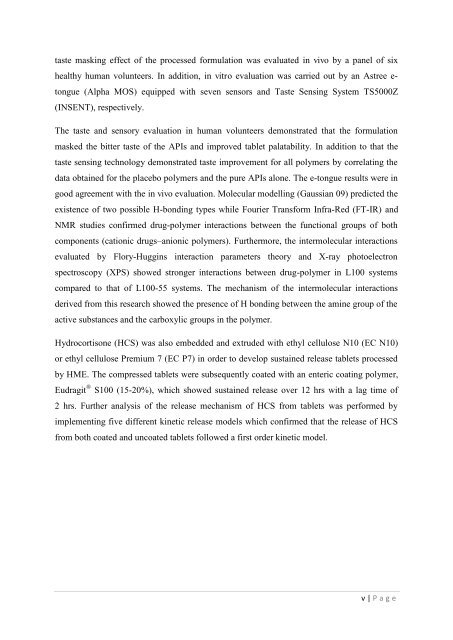Development of hot-melt extrusion as a novel technique for the ...
Development of hot-melt extrusion as a novel technique for the ...
Development of hot-melt extrusion as a novel technique for the ...
Create successful ePaper yourself
Turn your PDF publications into a flip-book with our unique Google optimized e-Paper software.
t<strong>as</strong>te m<strong>as</strong>king effect <strong>of</strong> <strong>the</strong> processed <strong>for</strong>mulation w<strong>as</strong> evaluated in vivo by a panel <strong>of</strong> sixhealthy human volunteers. In addition, in vitro evaluation w<strong>as</strong> carried out by an Astree e-tongue (Alpha MOS) equipped with seven sensors and T<strong>as</strong>te Sensing System TS5000Z(INSENT), respectively.The t<strong>as</strong>te and sensory evaluation in human volunteers demonstrated that <strong>the</strong> <strong>for</strong>mulationm<strong>as</strong>ked <strong>the</strong> bitter t<strong>as</strong>te <strong>of</strong> <strong>the</strong> APIs and improved tablet palatability. In addition to that <strong>the</strong>t<strong>as</strong>te sensing technology demonstrated t<strong>as</strong>te improvement <strong>for</strong> all polymers by correlating <strong>the</strong>data obtained <strong>for</strong> <strong>the</strong> placebo polymers and <strong>the</strong> pure APIs alone. The e-tongue results were ingood agreement with <strong>the</strong> in vivo evaluation. Molecular modelling (Gaussian 09) predicted <strong>the</strong>existence <strong>of</strong> two possible H-bonding types while Fourier Trans<strong>for</strong>m Infra-Red (FT-IR) andNMR studies confirmed drug-polymer interactions between <strong>the</strong> functional groups <strong>of</strong> bothcomponents (cationic drugs–anionic polymers). Fur<strong>the</strong>rmore, <strong>the</strong> intermolecular interactionsevaluated by Flory-Huggins interaction parameters <strong>the</strong>ory and X-ray p<strong>hot</strong>oelectronspectroscopy (XPS) showed stronger interactions between drug-polymer in L100 systemscompared to that <strong>of</strong> L100-55 systems. The mechanism <strong>of</strong> <strong>the</strong> intermolecular interactionsderived from this research showed <strong>the</strong> presence <strong>of</strong> H bonding between <strong>the</strong> amine group <strong>of</strong> <strong>the</strong>active substances and <strong>the</strong> carboxylic groups in <strong>the</strong> polymer.Hydrocortisone (HCS) w<strong>as</strong> also embedded and extruded with ethyl cellulose N10 (EC N10)or ethyl cellulose Premium 7 (EC P7) in order to develop sustained rele<strong>as</strong>e tablets processedby HME. The compressed tablets were subsequently coated with an enteric coating polymer,Eudragit ® S100 (15-20%), which showed sustained rele<strong>as</strong>e over 12 hrs with a lag time <strong>of</strong>2 hrs. Fur<strong>the</strong>r analysis <strong>of</strong> <strong>the</strong> rele<strong>as</strong>e mechanism <strong>of</strong> HCS from tablets w<strong>as</strong> per<strong>for</strong>med byimplementing five different kinetic rele<strong>as</strong>e models which confirmed that <strong>the</strong> rele<strong>as</strong>e <strong>of</strong> HCSfrom both coated and uncoated tablets followed a first order kinetic model.v | P a g e
















